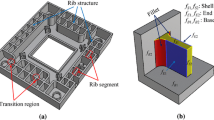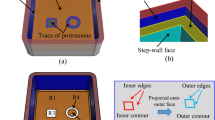Abstract
Volume decomposition is a technique for decomposing a computer-aided design (CAD) model into subvolumes to improve the types of meshes that can be generated and enhance the accuracy of finite element analysis. Protrusions frequently occur on thin-shell CAD models for functional and structural purposes. Automatic decomposition of such features is difficult due to the complexity and variation of shapes. In this study, a method was proposed for decomposing protrusions on thin-shell CAD models. A feature recognition algorithm was first employed to recognize four types of protrusions on a boundary representation (B-rep) model: tubes, columns, ribs, and symmetric extrusions. A specific volume decomposition algorithm was then developed for each type of protrusion. A protrusion is divided into sweepable subvolumes, with each subvolume represented by a pair of main contours and several side contours that connect to both main contours simultaneously. The contours of all subvolumes are tightly adjacent to each other to preserve the entire volume of the feature. Realistic CAD models and analysis results are presented to demonstrate the feasibility of the proposed protrusion decomposition method. The integration of the proposed algorithm with the decomposition of thin shells is also discussed.

































Similar content being viewed by others
References
Burkhart TA, Andrews DM, Dunning CE (2013) Finite element modeling mesh quality, energy balance and validation methods: a review with recommendations associated with the modeling of bone tissue. J Biomech 46(9):1477–1488
Sun L, Tierney CM, Armstrong CG, Robinson TT (2016) Automatic decomposition of complex thin walled CAD models for hexahedral dominant meshing. Procedia Eng 163:225–237
Yu Y, Liu JG, Zhang YJ (2021) HexDom: polycube-based hexahedral dominant mesh generation. In: The edited volume of mesh generation and adaptation: cutting-edge techniques for the 60th birthday of Oubay Hassan, SEMA-SIMAI Springer Series
Lu Y, Gadh R, Tautges TJ (2001) Feature based hex meshing methodology: feature recognition and volume decomposition. Comput Aided Des 33:221–232
White DR, Saigal S, Owen SJ (2004) CCSweep: automatic decomposition of multi-sweep volumes. Eng Comput 20:222–236
Wu H, Gao S (2014) Automatic swept volume decomposition based on sweep directions extraction for hexahedral meshing. In: 23rd international meshing roundtable, procedia eng, vol 82, pp 136‒148
Liu L, Zhang Y, Liu Y, Wang W (2015) Feature-preserving T-mesh construction using skeleton-based polycubes. Comput Aided Des 58:162–172
Hu K, Zhang YJ (2016) Centroidal Voronoi tessellation based polycube construction for adaptive all-hexahedral mesh generation. Comput Methods Appl Mech Eng 305:405–421
Sheen DP, Son TG, Myung DK, Lee SH, Lee K, Yeo TJ (2010) Transformation of a thin-walled solid model into a surface model via solid deflation. Comput Aided Des 42:720–730
Nolan DC, Tierney CM, Armstrong CG, Robinson TT, Makem JE (2014) Automatic dimensional reduction and meshing of stiffened thin-wall structures. Eng Comput 30(4):689–701
Liu SS, Gadh R (1998) Basic logical bulk shapes (BLOBs) for finite element hexahedral mesh generation to support virtual prototyping. J Manuf Sci Eng 120(4):728–735
Gadh R, Prinz FB (1995) A computationally efficient approach to feature abstraction in design-manufacturing integration. J Eng Ind 117:16–27
Luo XJ, Shephard MS, Yin LZ, O’Bara RM, Nastasi R, Beall MW (2010) Construction of near optimal meshes for 3D curved domains with thin sections and singularities for p-version method. Eng Comput 26:215–229
Hu K, Zhang YJ, Liao T (2017) Surface segmentation for polycube construction based on generalized centroidal Voronoi tessellation. Comput Methods Appl Mech Eng 316:280–296
Yu Y, Wei X, Li A, Liu JG, He J, Zhang YJ (2020) HexGen and Hex2Spline: polycube-based hexahedral mesh generation and unstructured spline construction for isogeometric analysis framework in LS-DYNA. In: Springer INdAM Serie: proceedings of INdAM workshop "Geometric Challenges in Isogeometric Analysis"
Lai JY, Wang MH, Song PP, Hsu CH, Tsai YC (2018) Automatic recognition and decomposition of rib features in thin-shell parts for mold flow analysis. Eng Comput 34:801–820
Lai JY, Song PP, Hsiao AS, Tsai YC, Hsu CH (2021) Recognition and classification of protrusion features on thin-wall parts for mold flow analysis. Eng Comput 37:833–854
Lai JY, Wu JW, Song PP, Chou TY, Tsai YC, Hsu CH (2021) Hybrid mesh generation for the thin shell of thin-shell plastic parts for mold flow analysis. Eng Comput (online)
Author information
Authors and Affiliations
Corresponding author
Additional information
Publisher's Note
Springer Nature remains neutral with regard to jurisdictional claims in published maps and institutional affiliations.
Rights and permissions
About this article
Cite this article
Song, PP., Putrayudanto, P., Wu, TY. et al. Decomposition of protrusion features on thin-shell parts for mold flow analysis. Engineering with Computers 39, 2757–2789 (2023). https://doi.org/10.1007/s00366-022-01657-y
Received:
Accepted:
Published:
Issue Date:
DOI: https://doi.org/10.1007/s00366-022-01657-y




